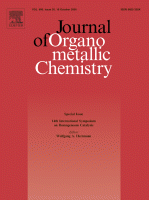







|
|
|
Journal
Publications |
|
Iminophosphines: Synthesis, Formation of
2,3-dihydro-1H-benzo[1,3]azaphosphol-3-ium salts and N-(pyridin-2-yl)-2-diphenylphosphinoylaniline,
Coordination Chemistry and Applications in Platinum Group Catalyzed
Suzuki Coupling Reactions and Hydrosilylations.
Simon Doherty, Julian G. Knight, Tom H.
Scanlan, Mark R.J. Elsegood, and William Clegg, J. Organomet. Chem.,
2002, 650, 231. |
|
Abstract: The aprotic and protic bi- and multidentate
iminophosphines 2-Ph2PC6H4N=CR1R2
(R1=H, R2=Ph=2a; R1=Me
R2=Ph=2b; R1=H, R2=2-thienyl=2c;
R1=H, R2=C6H4-2-PPh2=2d;
R1=H, R2=C6H4-2-OH=2e,
R1=H, R2=C6H4-2-OH-3-But=2f;
R1=H, R2=CH2C(O)Me=2g)
have been prepared by the acid catalyzed condensation of
2-(diphenylphosphino)aniline with the corresponding aldehyde–ketone.
Iminophosphine 2d can be reduced with sodium
cyanoborohydride to give the corresponding amino-diphosphine 2-Ph2PC6H4N(H)CH2C6H4-2-PPh2
(2h). In the presence of a stoichiometric quantity of
acid, 2-(diphenylphosphino)aniline reacts in an unexpected manner with
benzaldehyde, salicylaldehyde, or acetophenone to give the corresponding
2,3-dihydro-1H-benzo[1,3]azaphosphol-3-ium salts and with
pyridine-2-carboxaldehyde to give N-(pyridin-2-ylmethyl)-2-diphenylphosphinoylaniline,
the latter of which has been characterized by single-crystal X-ray
crystallography, as its palladium dichloride derivative. The attempted
condensation of 2-(diphenylphosphino)aniline with
pyridine-2-carboxaldehyde to give the corresponding
pyridine-functionalized iminophosphine resulted in an unusual
transformation involving the diastereoselective addition of two
equivalents of aldehyde to give 1,2-dipyridin-2-yl-2-(o-diphenylphosphinoyl)phenylamino-ethanol,
which has been characterized by a single-crystal X-ray structure
determination. The bidentate iminophosphine 2-Ph2PC6H4N=C(H)Ph
reacts with [(cycloocta-1,5-diene)PdClX] X=Cl, Me) to give [Pd{2-Ph2PC6H4N=C(H)Ph}ClX]
and the imino-diphosphine 2-Ph2PC6H4N=C(H)C6H4-PPh2
reacts with [(cycloocta-1,5-diene)PdClMe] to give [Pd{2-Ph2PC6H4N=C(H)C6H4---PPh2}ClMe]
and each has been characterized by single-crystal X-ray crystallography.
The monobasic iminophosphine 2-Ph2PC6H4N=C(Me)CH2C(O)Me
reacts with [Ni(PPh3)2Cl2] in the
presence of NaH to give the phosphino–ketoiminate complex [Ni{2-Ph2PC6H4N=C(Me)CHC(O)Me}Cl],
which has been structurally characterized. Mixtures of iminophosphines
2a–h and a palladium source catalyze
the Suzuki cross coupling of 4-bromoacetophenone with phenyl boronic
acid. The efficiency of these catalysts show a marked dependence on the
palladium source, catalysts formed from [Pd2(OAc)6]
giving consistently higher conversions than those formed from [Pd2(dba)3]
and [PdCl2(MeCN)2]. Catalysts formed from neutral
bi- and terdentate iminophosphines 2a–d
gave significantly higher conversions than those formed from their
monobasic counterparts 2e–f. Notably,
under our conditions the conversions obtained with 2a–c
compare favorably with those of the standards; catalysts formed from
tris(2-tolyl)phosphine and tris(2,4-di-tert-butylphenyl)phosphite
and a source of palladium. In addition, mixtures of [Ir(COD)Cl]2
and 2a–h are active for the
hydrosilylation of acetophenone; in this case catalysts formed from
monobasic iminophosphines 2e–f giving
the highest conversions. |
|



